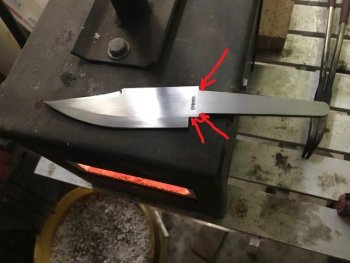opaul, I initially wrote this last night and then hesitated as you are not asking for advice but this is something I was taught from the time I started knife making! One of the first things known makers told me it that square inside corners or 90* corners, were a perfect place for stress fractures to start!
Those inside square corners will often cause a stress factor during the quench! If you leave the inside corner rounded even slightly there is less chance of that happening!!
View attachment 68761Well try as I might I having trouble finding documentation for this problem. Except for this one,
https://knifedogs.com/search/261304/?q=stress+fractures+from+inside+corners&o=date
When starting to square off for the guard or at the ricasso if you use a round file in the corner and then square off the remainder, is suppose to be the better idea! Something like this! Sorry this is such a bad photo but you can see the radius somewhat! The area the guard is fitted to is also radiused!
View attachment 68765
Any way I like the profile of this one! This is information you can file away for later projects!!








